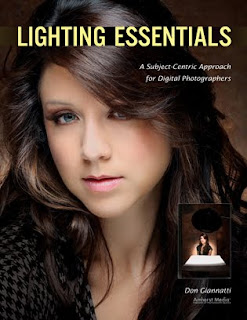 Today's post comes from the book Boutique Baby Photography: The Digital Photographer's Guide to Success in Maternity and Baby Portraiture by Mimika Cooney. It is available from Amazon.com and other fine retailers.
Today's post comes from the book Boutique Baby Photography: The Digital Photographer's Guide to Success in Maternity and Baby Portraiture by Mimika Cooney. It is available from Amazon.com and other fine retailers.Clothing Choices. Babies are best photographed in their birthday suits—just plain naked. Most clothing swallows up a newborn and disguises what’s so cute about their tiny shape. The parents’ own clothing choices should be simple and neutral. You want to highlight their relationship and special bond with their new baby, not their outfits. Plain black long-sleeved shirts with jeans work very well.
Moms just love seeing Daddy shirtless holding his little baby bundle—and there really is something special and heartwarming about seeing a dad’s strength in contrast with the delicateness of a newborn baby. So off with the shirts, Dads! Even if the father is not completely comfortable with his shape, you can use lighting to artistically hide the areas he doesn’t want highlighted (usually the arms and tummy).



 Moms love shirtless dads—and portraits like these let you tell a story by contrasting the delicate with the strong. Using dramatic lighting you can artistically hide any areas that Dad isn’t comfortable having seen.
Moms love shirtless dads—and portraits like these let you tell a story by contrasting the delicate with the strong. Using dramatic lighting you can artistically hide any areas that Dad isn’t comfortable having seen. Accidents Will Happen! With most newborns, we’re tempting fate with those cute curled-up naked baby portraits. I always tell parents, “It’s not if but when.” Don’t panic; just be prepared for pee and poo accidents, keeping clean-up supplies at the ready. In my studio, we have an easily wipeable floor, loads of antibacterial wipes, paper towels, and hand sanitizer. Very often, the baby will warn you that they need to go by crying and wriggling. If they do, place a clean diaper loosely under their buttocks until they settle. It’s also advisable for the adults to bring an extra set of clothing; the probability is very high that someone is going to get wet!
What to Do When Baby Cries. Sometimes even adults wake up on the wrong side of the bed, so it is completely understandable that a child might cry during a photo session. If that happens, it’s best to pause the photography and give the little one a hug and cuddle to make them feel secure. The bright flashing lights, strange noises, and unfamiliarity can cause uncertainty. Crying may also be a sign that the child has passed their patience threshold. In that case, there is no use in forcing the matter; just wrap up the session quickly. They may even be unwell or coming down with a cold. If that is the case, reschedule the session for when they are feeling better. However, if it really is just a case of nerves, then a really talented photographer should be able to offer distractions to both the mom and the child and re-focus them when they feel at ease again.
Usually, persistent crying is baby’s sign that they are tired or about to fill up their diaper. If you can bear through the howling, swaddle them and rock them until they nod off. A great tip I got from the baby-whisperer Tracy Hogg is to use techniques in threes. For example, pat the baby’s back while “shooshing” loudly enough that the baby can hear it over their own crying, also while rocking. I like to use a sound machine that mimics womb sounds to offer that familiar heart-pumping the baby got used to in Mom’s tummy. Remember that, just days ago, the baby was tightly curled up in the womb, so all the flailing about they now find themselves able to do makes them feel insecure.
Always have an assuring hand on the baby’s back or head to offer that feeling of warmth and security. Also, have Mom feed the baby in between poses; a full belly helps them sleep. Another great tip is to place a heating pad, gently warmed in the microwave, under a blanket and lay the baby on their side or tummy.



















